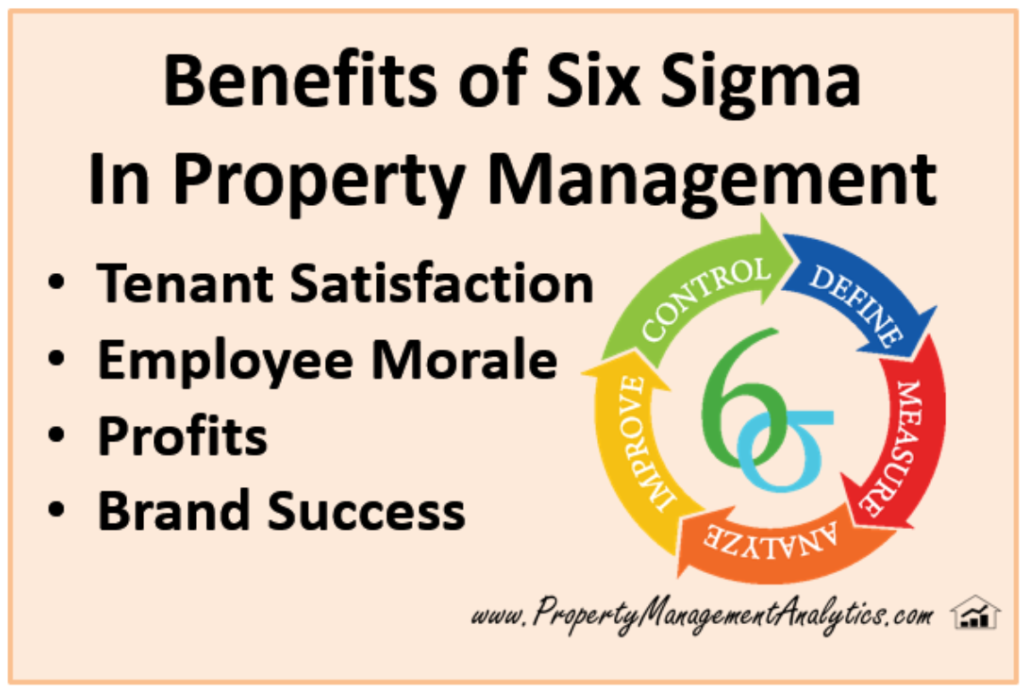Six sigma can help property management executives improve profits, employee morale and tenant satisfaction. Six sigma is a set of methods designed to improve processes. It has been successfully used at companies like Motorola, GE and Honeywell, but it is not useful only to large companies. Six Sigma in property management is not something I have come across, and I think property management executives who develop a basic understanding of it can make significant improvements.
In plain English, if you want your organization to consistently do things right (such as processing lease applications, resolving maintenance requests, collecting rent on time etc.), then Six Sigma can help you get there.
Why Six Sigma in Property Management
Property management is very people-driven. People want consistency and predictability. When your leasing office consistently responds promptly to inquiries, or, when prospects are consistently given the information needed to understand the lease terms, or, when your maintenance personnel can be consistently counted on to show up on time for their appointments, you have removed variation from these processes. There are many ways to achieve consistency, and Six Sigma is a proven, data-driven method for making long-lasting process improvements.
Six Sigma in Property Management: An Illustration
Imagine you are meeting with your team to brainstorm why units are sometimes not ready for move-in by the date promised to new tenants. You don’t know how many times this has actually happened in the past year, but it is a very serious situation when it does happen. A team member has an explanation for why it happens (“Joe dropped the ball each time”) and recommends replacing Joe with Steve. You agree and move on to the next topic.
Now, if your team was already exposed to the Six Sigma philosophy, the above meeting would have gone very differently. The problem of units not being ready by move-in date would have been approached using the “DMAIC” framework.
DMAIC Applied to a Property Management Problem
Here I share an example Six Sigma in property management by showing how a team used the DMAIC cycle to resolve the “Unit not ready on move in date” problem.

| Phase / Questions | Findings / Actions |
| Define
· What problem are we trying to solve? · Is it important to our customers?
|
Problem: Sometimes the apartment is not ready on the day the new tenant expects to move in.
Each occurrence is extremely significant. It hurts our image and causes significant inconvenience to our new tenants. |
| Measure
· How often do we have this situation? · What is the financial impact of each occurrence? · What is the impact on employee morale, customer satisfaction and other metrics that matter to our business strategy? |
Out of the 500 most recent new leases, the unit was not ready by the move-in date 7 times.
Two tenants cancelled their leases. We got 5 scathing reviews on social media. Employees have to work with irate customers. That is demoralizing. Employees have to drop what they are doing to assist the tenant. Fingers get pointed and our team morale is hurt.
|
| Analyze
· Why does this problem happen? · What is the step by step process flow? · What are the hand-offs involved? · What is the root cause? |
A flow chart was created showing all the teams involved in getting a unit ready for move in.
The flow chart also shows when the “move in date” is communicated to the tenant and to the leasing and turnover teams. It became clear that the vacant units with the upcoming move in dates are not visible to those supervising the turnover work. Each time problem-solving team had a possible cause, the executive asked “Why?” until they collectively arrived at the root causes. |
| Improve
· What changes are required to address the root cause? · What training do we need to provide? · What checklists need to be created? · How do we measure outcomes?
|
A “hot list” of units being turned over was created. This list showed the “Promised Move In Date”.
The property manager shares the list with the crew chiefs so that they can prioritize their work. They confirm that the list helps them be proactive. |
| Control
· How do we sustain the process changes to ensure they are consistently implemented?
|
Reviewing the hot list has become part of the daily standup meetings.
The director of maintenance now confirms at the meeting that the units with move-in dates in the next seven days are being worked on and will be ready for move in. “Unit Not Ready On Move In Date” is now a performance measure for the property manager. |



